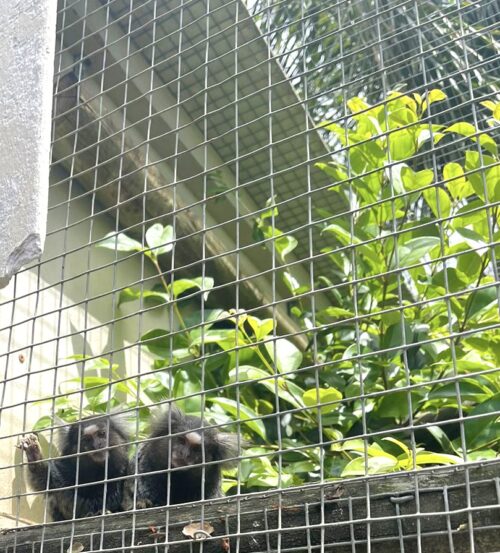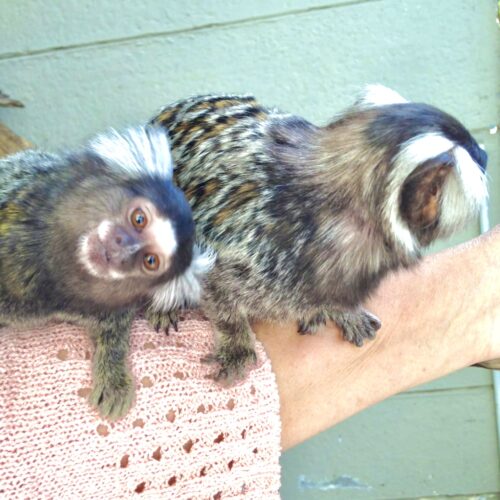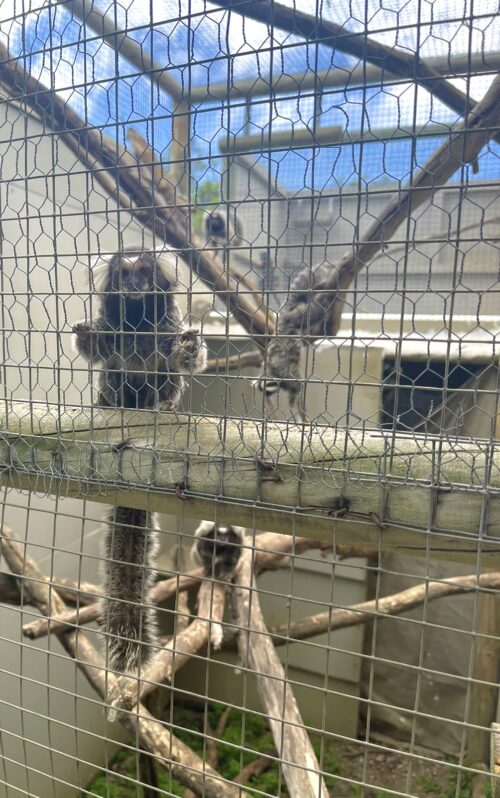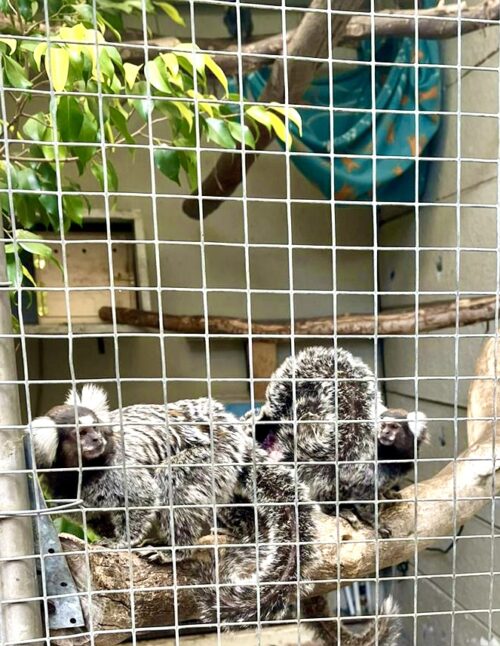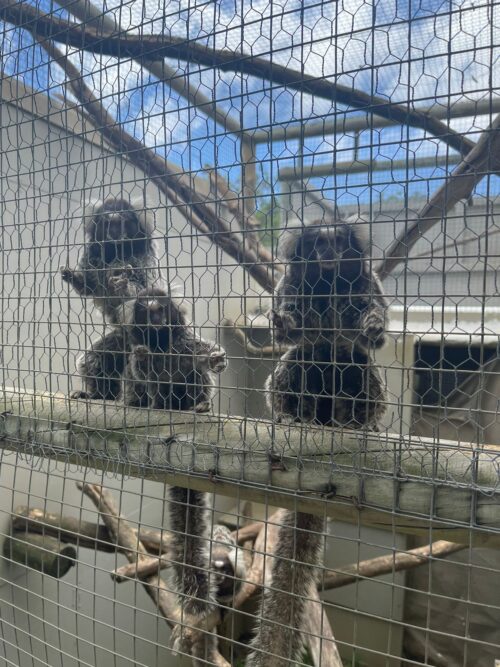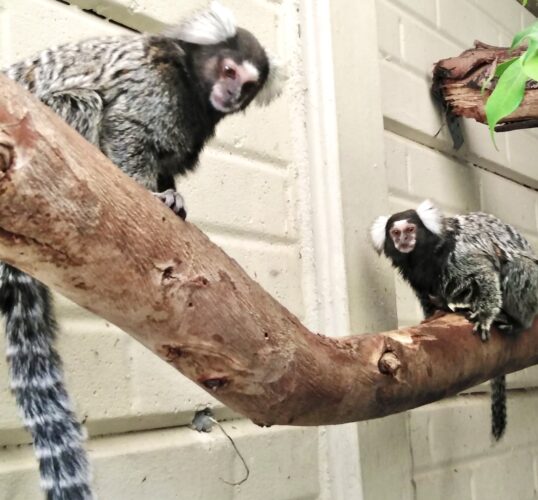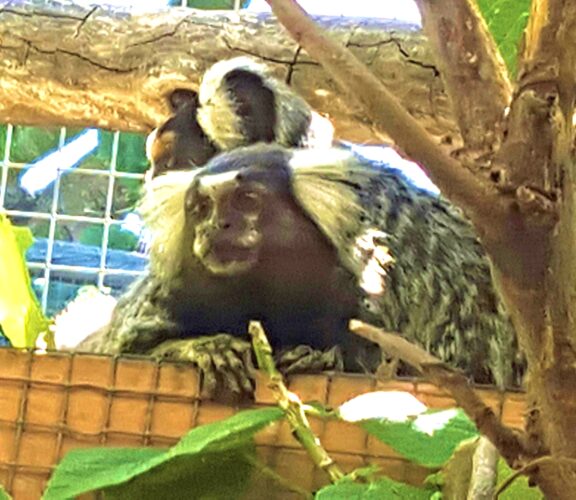
Callithrix jacchus
The Common Marmoset, also called White-tufted Ear, or white-tufted~, Marmoset Callithrix jacchus is another one of the New World Primate species
Physical Attributes:
Common marmosets are very small primates with relatively long tails. Moreover, the males and females are similar in size, with males being slightly larger. Furthermore, the fur of the marmoset is multi-coloured, being sprinkled with brown, grey, and yellow. In addition, it also has white ear tufts and the tail is banded. Their faces have black across their nose area skin as well as a white blaze on the forehead. What’s more, is the coats of infants are brown and yellow. Lastly, the ear tufts develop a little later.
Origins:
They originate from the northeastern coast of Brazil, in the states of Piaui, Paraibu, Ceará, Rio Grande do Norte, Pernambuco, Alagoas and Bahia. Through release (both intentional and unintentional) of captive individuals, it has expanded its range since the 1920s to southeast Brazil with its first sighting in the wild for Rio de Janeiro was in 1929, where it became an invasive species, raising concerns about genetic pollution of similar species, such as the buffy-tufted marmoset Callithrix aurita, and predation upon bird nestlings and eggs.
Reproduction:
Adult females breed regularly throughout their lives. The gestation period lasts for 5 months, and then females are ready to breed again around 10 days after giving birth, so they can give birth twice a year in conducive conditions. Marmosets commonly give birth to nonidentical twins. Infant marmosets instinctively cling to their mother’s back and do not voluntarily let go for the first two weeks. After that, they become very active and explore their environment.
Maturity:
Infants are weaned at 3 months. At 5 months, they enter their juvenile stage and then become subadults between 9 and 14 months old, act like adults, and go through puberty. Lastly, at 15 months, they reach adult size and are sexually mature.
We have included official References below should you wish to learn more about the Common Marmoset..
References:
- Groves, C. P. (2005). Wilson, D. E.; Reeder, D. M. (eds.). Mammal Species of the World: A Taxonomic and Geographic Reference (3rd ed.). Baltimore: Johns Hopkins University Press. p. 131. ISBN 0-801-88221-4. OCLC 62265494.
- ^ Rylands AB, Mittermeier RA (2009). “The Diversity of the New World Primates (Platyrrhini)”. In Garber PA, Estrada A, Bicca-Marques JC, Heymann EW, Strier KB (eds.). South American Primates: Comparative Perspectives in the Study of Behavior, Ecology, and Conservation. Springer. pp. 23–54. ISBN 978-0-387-78704-6.
- ^ Valença-Montenegro, M.M.; Bezerra, B.M.; Ruiz-Miranda, C.R.; Pereira, D.G.; Miranda, J.M.D.; Bicca-Marques, J.C.; Oliveira, L.; da Cruz, M.A.O.M.; Valle, R.R.; Mittermeier, R.A. (2021). “Callithrix jacchus“. IUCN Red List of Threatened Species. 2021: e.T41518A191705043. doi:10.2305/IUCN.UK.2021-1.RLTS.T41518A191705043.en. Retrieved 12 November2021.
- ^ Jump up to: a b Worley, Kim C; Warren, Wesley C; Rogers, Jeffrey; et al. (2014). “The common marmoset genome provides insight into primate biology and evolution”. Nat Genet. 46(8): 850–857. doi:10.1038/ng.3042. PMC 4138798. PMID 25038751.
- ^ Jump up to: a b Baylor College of Medicine. “Marmoset sequence sheds new light on primate biology and evolution”. ScienceDaily. Retrieved 21 July 2014.
- ^ Garber PA, Rosenberger AL, Norconk MA. (1996) “Marmoset misconceptions”. In: Norconk MA, Rosenberger AL, Garber PA, editors. Adaptive radiations of neotropical primates. New York: Plenum Pr. pp. 87–95.
- ^ Jump up to: a b c d Kinzey WG. 1997. “Synopsis of New World primates (16 genera) “. In: Kinzey WG, editor. New world primates: ecology, evolution, and behavior. New York: Aldine de Gruyter. pp. 169–324.
- ^ Rylands AB, Coimbra-Filho AF, Mittermeier RA. 1993. “Systematics, geographic distribution, and some notes on the conservation status of the Callitrichidae”. In: Rylands AB, editor. Marmosets and tamarins: systematics, behaviour, and ecology. Oxford (England): Oxford Univ Pr. pp. 11–77.
- ^ Jump up to: a b c Rylands AB, de Faria DS. (1993) “Habitats, feeding ecology, and home range size in the genus Callithrix”. In: ‘Rylands AB, editor. Marmosets and tamarins: systematics, behaviour, and ecology. Oxford (England): Oxford Univ Pr. pp. 262–72.
- ^ Jump up to: a b Ferrari, SF; Lopes Ferrari, MA (1989). “A re-evaluation of the social organization of the Callitrichidae, with reference to the ecological differences between genera”. Folia Primatol. 52 (3–4): 132–47. doi:10.1159/000156392. PMID 2515129.
- ^ Jump up to: a b c d e f g h i j Stevenson MF, Rylands AB. (1988) “The marmosets, genus Callithrix”. In: Mittermeier RA, Rylands AB, Coimbra-Filho AF, da Fonseca GAB, editors. Ecology and behavior of neotropical primates, Volume 2. Washington DC: World Wildlife Fund. pp. 131–222.
- ^ Jump up to: a b c d Digby, LJ (1995). “Social organization in a wild population of Callithrix jacchus: II, Intragroup social behavior”. Primates. 36 (3): 361–75. doi:10.1007/bf02382859. S2CID 21445768.
- ^ Jump up to: a b c Ferrari, SF; Digby, LJ (1996). “Wild Callithrix group: stable extended families?”. Am J Primatol. 38 (1): 19–27. doi:10.1002/(sici)1098-2345(1996)38:1<19::aid-ajp3>3.3.co;2-f. PMID 31914711.
- ^ Jump up to: a b Lazaro-Perea, C (2001). “Intergroup interactions in wild common marmosets, Callithrix jacchus: territorial defense and assessment of neighbours”. Anim Behav. 62: 11–21. doi:10.1006/anbe.2000.1726. S2CID 53157937.
- ^ Jump up to: a b Arruda, MF; Araujo, A; Sousa, MBC; et al. (2005). “Two breeding females within free-living groups may not always indicate polygyny: alternative subordinate female strategies in common marmosets (Callithrix jacchus)”. Folia Primatol. 76 (1): 10–20. doi:10.1159/000082451. PMID 15711070. S2CID 26930618.
- ^ Baker, JV; Abbott, DH; Saltzman, W (1999). “Social determinants of reproductive failure in male common marmosets housed with their natal family”. Anim Behav. 58(3): 501–13. doi:10.1006/anbe.1999.1200. PMID 10479365. S2CID 2666384.
- ^ Jump up to: a b c Saltzman, W; Severin, JM; Schultz-Darken, NJ; Abbott, DH (1997). “Behavioral and social correlates of escape from suppression of ovulation in female common marmosets with the natal family”. Am J Primatol. 41: 1–21. doi:10.1002/(sici)1098-2345(1997)41:1<1::aid-ajp1>3.0.co;2-0.
- ^ Jump up to: a b c Yamamoto ME. (1993) From dependence to sexual maturity: the behavioural ontogeny of Callitrichidae”. In: Rylands AB, editor. Marmosets and tamarins: systematics, behaviour, and ecology. Oxford (England): Oxford Univ Pr. pp. 235–54.
- ^ Jump up to: a b Jones CB. (1997) “Quantitative analysis of marmoset vocal communication”. In: Pryce C, Scott L, Schnell C, editors. Marmosets and tamarins in biological and biomedical research: proceedings of a workshop. Salisbury (UK): DSSD Imagery. pp. 145–51.
- ^ Jump up to: a b Abbott, DH; Barnett, DK; Colman, RJ; et al. (2003). “Aspects of common marmoset basic biology and life history important for biomedical research”. Comp Med. 53 (4): 339–50. PMID 14524409.
- ^ Rylands AB. (1997) “The callitrichidae: a biological overview”. In: Pryce C, Scott L, Schnell C, editors. Marmosets and tamarins in biological and biomedical research: proceedings of a workshop. Salisbury (UK): DSSD Imagery. pp. 1–22.

